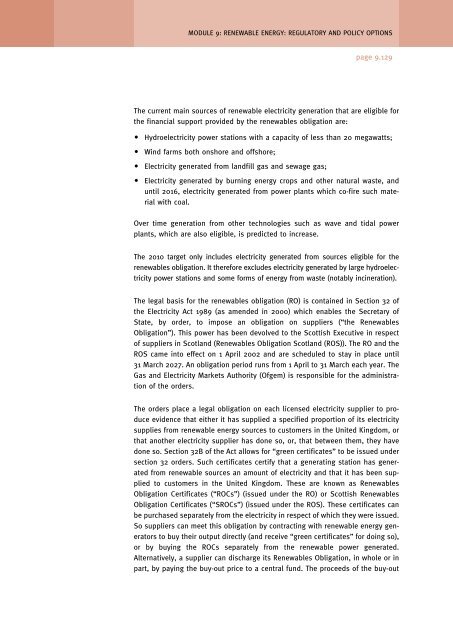Regulatory and policy options to encourage development of ...
Regulatory and policy options to encourage development of ...
Regulatory and policy options to encourage development of ...
- No tags were found...
Create successful ePaper yourself
Turn your PDF publications into a flip-book with our unique Google optimized e-Paper software.
MODULE 9: RENEWABLE ENERGY: REGULATORY AND POLICY OPTIONSpage 9.129The current main sources <strong>of</strong> renewable electricity generation that are eligible forthe financial support provided by the renewables obligation are: Hydroelectricity power stations with a capacity <strong>of</strong> less than 20 megawatts; Wind farms both onshore <strong>and</strong> <strong>of</strong>fshore; Electricity generated from l<strong>and</strong>fill gas <strong>and</strong> sewage gas; Electricity generated by burning energy crops <strong>and</strong> other natural waste, <strong>and</strong>until 2016, electricity generated from power plants which co-fire such materialwith coal.Over time generation from other technologies such as wave <strong>and</strong> tidal powerplants, which are also eligible, is predicted <strong>to</strong> increase.The 2010 target only includes electricity generated from sources eligible for therenewables obligation. It therefore excludes electricity generated by large hydroelectricitypower stations <strong>and</strong> some forms <strong>of</strong> energy from waste (notably incineration).The legal basis for the renewables obligation (RO) is contained in Section 32 <strong>of</strong>the Electricity Act 1989 (as amended in 2000) which enables the Secretary <strong>of</strong>State, by order, <strong>to</strong> impose an obligation on suppliers (“the RenewablesObligation”). This power has been devolved <strong>to</strong> the Scottish Executive in respec<strong>to</strong>f suppliers in Scotl<strong>and</strong> (Renewables Obligation Scotl<strong>and</strong> (ROS)). The RO <strong>and</strong> theROS came in<strong>to</strong> effect on 1 April 2002 <strong>and</strong> are scheduled <strong>to</strong> stay in place until31 March 2027. An obligation period runs from 1 April <strong>to</strong> 31 March each year. TheGas <strong>and</strong> Electricity Markets Authority (Ofgem) is responsible for the administration<strong>of</strong> the orders.The orders place a legal obligation on each licensed electricity supplier <strong>to</strong> produceevidence that either it has supplied a specified proportion <strong>of</strong> its electricitysupplies from renewable energy sources <strong>to</strong> cus<strong>to</strong>mers in the United Kingdom, orthat another electricity supplier has done so, or, that between them, they havedone so. Section 32B <strong>of</strong> the Act allows for “green certificates” <strong>to</strong> be issued undersection 32 orders. Such certificates certify that a generating station has generatedfrom renewable sources an amount <strong>of</strong> electricity <strong>and</strong> that it has been supplied<strong>to</strong> cus<strong>to</strong>mers in the United Kingdom. These are known as RenewablesObligation Certificates (“ROCs”) (issued under the RO) or Scottish RenewablesObligation Certificates (“SROCs”) (issued under the ROS). These certificates canbe purchased separately from the electricity in respect <strong>of</strong> which they were issued.So suppliers can meet this obligation by contracting with renewable energy genera<strong>to</strong>rs<strong>to</strong> buy their output directly (<strong>and</strong> receive “green certificates” for doing so),or by buying the ROCs separately from the renewable power generated.Alternatively, a supplier can discharge its Renewables Obligation, in whole or inpart, by paying the buy-out price <strong>to</strong> a central fund. The proceeds <strong>of</strong> the buy-out










